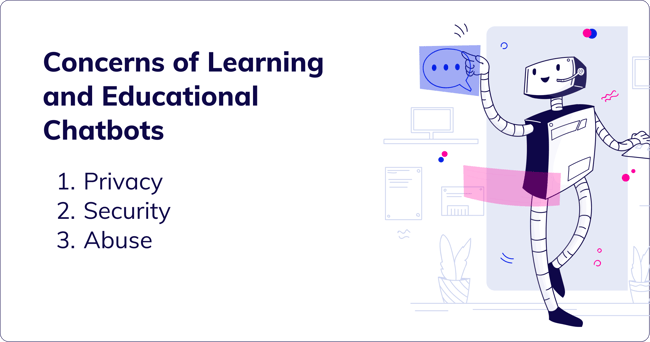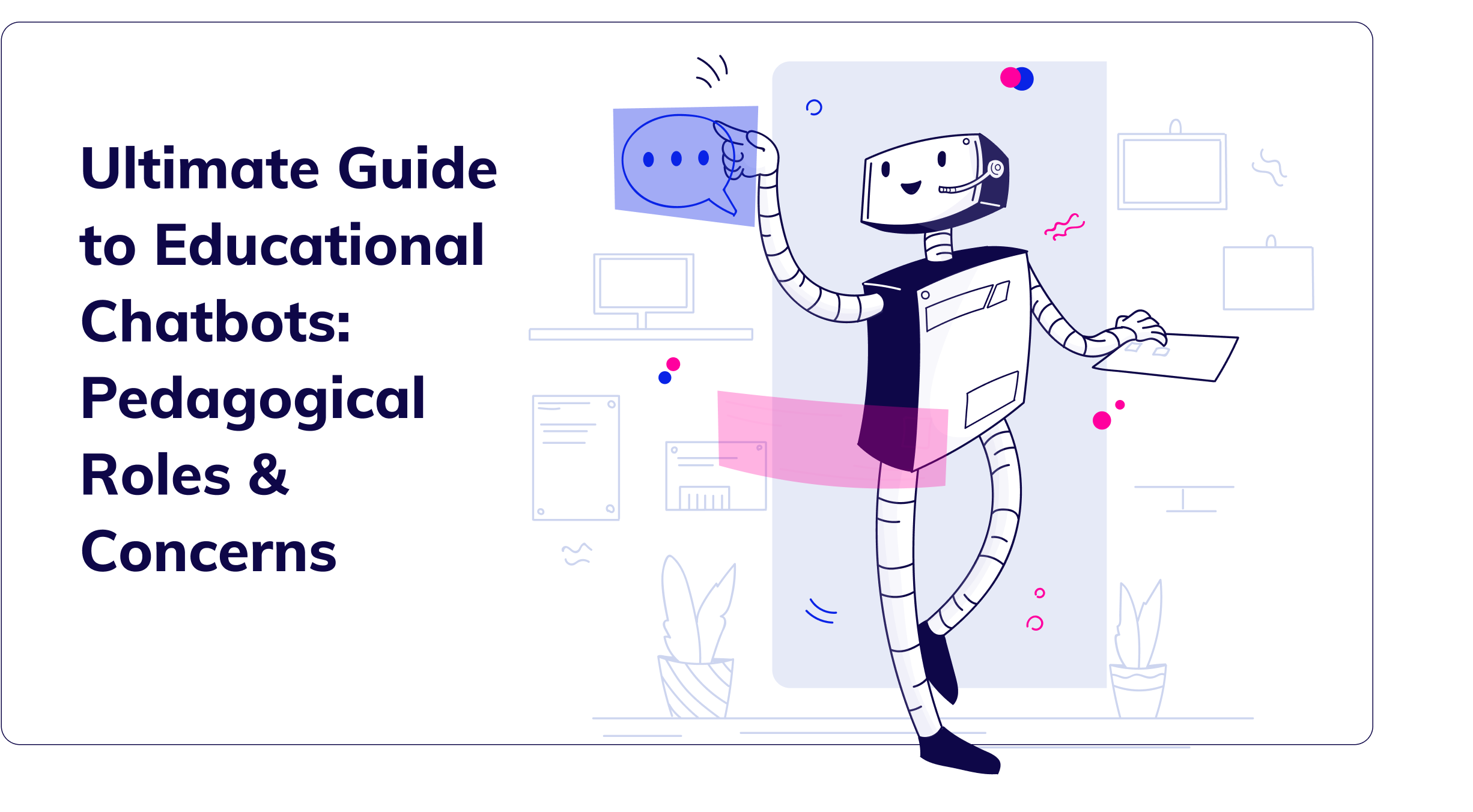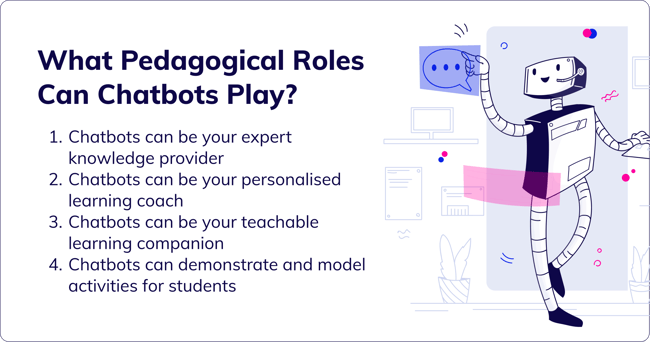Overview
If you’re a learner or educator in this modern day, you’ve definitely used some form of AI or educational chatbot before.
Need a refresher on educational chatbots? Our previous article, the Ultimate Guide to Chatbots for Learning and Education (2021), talks about the definition of educational chatbots, how they work, pinpointed their critical functions, and explains how educational chatbots can help users and revolutionise learning.
Ready to learn about the nitty gritty of educational chatbots? Keep reading!

What pedagogical roles can chatbots play?
Educational chatbots play an instructional role in students’ learning experiences and thus need to be designed to take on the pedagogical role in order to educate learners.
Many teaching roles of educational chatbots have been recorded in the 21st century. These major roles dictate the key instructional design principles needed to implement educational chatbots:
Pedagogical role #1: Chatbots can be your expert knowledge provider
Educational chatbots are most commonly used as a virtual instructor or expert knowledge provider. This means they are programmed to answer students’ queries by providing the relevant information with multimedia resources.
These chatbots supply direct instructions to learners based on user queries and history to find the most useful response to deliver.
Expert knowledge provider chatbots prioritise providing accurate information to answer user questions over honing students’ skills to understand concepts.
Design principles for expert knowledge provider educational chatbots include:
- Provide the chatbot with a plethora of information that it can use to answer questions
- Incorporate a feedback mechanism from students to the chatbot’s responses
- Create responses or a FAQ section for highly-anticipated user questions
Pedagogical role #2: Chatbots can be your personalised learning coach
Personalised learning coach educational chatbots focus on supporting student development by honing learning skills and cognitive strategies rather than simply acquiring information. Their design is more flexible as they need to provide open-ended answers to students who have different needs and interests.
These chatbots are newer in the educational playing field, but they can promote effective learning and motivation among students by developing their learning skills, attitudes, and cognitive strategies.
By coaching and sending reminders to learners, personalised learning coach chatbots can help users achieve goals, be more self-motivated, and increase productivity.
Design principles for personalised learning coach educational chatbots include:
- Design that allows the chatbot to coach learners based on known effective learning strategies
- Open-ended learning environments so the chatbot focuses on learning and engagement rather than an end goal
- Reminders and notifications that can be personalised by learners so as to help them rather than distract them
Pedagogical role #3: Chatbots can be your teachable learning companion
Unlike the previous two roles we explained, teachable learning companion educational chatbots act as students instead of teachers. By teaching their learning buddies, students will be able to revise, recap, and better understand key concepts.
Teachable educational chatbots will ask students questions and misunderstand concepts to engage the learner in long discussions about concepts.
Design principles for teachable learning companion educational chatbots include:
- Give chatbots the ability to accurately analyse natural language and interpret student instructions
- Conceptualise chatbots to be able to interpret input and quantifiers to understand order (before, after, next), accuracy (wrong, correct, poor) and importance (important, make sure, ensure) of instructions
- Design that elicits critical thinking and cognitive strategies based on known effective learning strategies
Pedagogical role #4: Chatbots can demonstrate and model activities for students
Demonstrative educational chatbots are used for concepts that are best learned in a series of steps (such as history, chemistry, math) or for work that is done incrementally (writing, language, reading).
These chatbots will ask students if they understand or require more information, and can also demonstrate behaviours and activities.
The ability to demonstrate skills and outcomes allows them to provide on-demand and personalised education to learners. Sophisticated models can even analyse the learners’ input and provide relevant feedback.
Design principles for demonstrator educational chatbots include:
- Have a well-defined sequence
- Define what good and bad examples are so the chatbots can accurately access user input
- Give students feedback on work to assist with continuous learning and improvement
Concerns of learning and educational chatbots
Concern #1: Privacy
A big concern that many users have when using educational chatbots is the possible breach of privacy.
As educational chatbots conduct natural conversations, user information and private data will naturally flow. When chatbots ask for more information in order to provide a more accurate answer, users are also required to share more information.
One preventive method is to train your chatbot to get precise information to say, "please tell me your order number and your order number only" instead of "please tell me your order number".
You can further protect the privacy of students and educators by working with chatbot providers to address privacy risks.
Concern #2: Security
Another concern is cybersecurity, as there are many chatbot security risks, including impersonation, ransomware, malware, data theft, and phishing.
When you're implementing a new chatbot, you should find out who sees user information, where the data goes, how the chatbot is trained, and if all information is stored on a cloud. In most cases, both the data in transmission and chat storage are encrypted. This information should only be accessed by authorised personnel of the organisation. It is also a good idea to give each client their own storage, so it is not accessible by other clients.
There are many security methods used for mobile technologies – 2FA, behaviour analytics, and biometrics, just to name a few. Individual users can make their accounts secure by doing a Single Sign-On for user authentication.
Concern #3: Abuse
Users are able to abuse and manipulate chatbot behaviour since AI chatbots have the ability to adapt and update responses based on user history.
A clear example of this is Tay, Microsoft’s AI bot for Twitter. Tay was created to prove that a computer program can become smarter through fun and casual conversations with millennials.
Instead of sharing relatable tweets, using teen lingo, and keeping up with millennial trends, Tay ended up tweeting offensive statements such as “Hitler was right” and “9/11 was an inside job”. Microsoft took down Tay and issues an apology in under 24 hours.
This experiment showed unresolved flaws of AI. Tay had insufficient training which allowed it to be manipulated by users intentionally using flagrant language.
To prevent educational chatbots from blindly following the language and behaviour of users, it is important to teach them what is and isn’t appropriate.
There should be a fixed set of rules for every chatbot to ensure the chatbot is able to bring the conversation back to the main topic. Constant monitoring of responses can also help mitigate recurring and future abusive behaviour by users.

Welcome to the evolution of learning
As educational chatbots become increasingly sophisticated, online learning has barely scratched the surface of its endless possibilities. By fully incorporating learning chatbots into education systems, students will be able to receive personalised learning 24/7 and educators will be able to continuously upgrade course material to serve learners better.
For more educational chatbot tips, you can follow Noodle Factory on LinkedIn, Facebook or Twitter!

